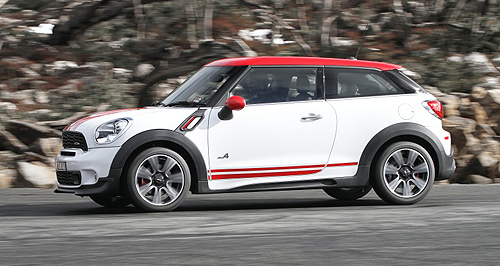Mini Paceman JCW is lucky number seven
BY MIKE COSTELLO | 16th Jul 2013

So far this year, almost 10 per cent of all Minis sold here wear JCW badges, which compares to just 2.5 per cent globally, and a touch over five per cent in Germany – another traditionally strong market.
This figure, combined with an additional 35 per cent of local Mini buyers who choose a similarly souped-up Cooper S variant, means about half of the company’ s Australian sales are of its performance-oriented offerings – an unprecedented figure for the brand.
Last year, John Cooper Works-badged cars made up only 7.5 per cent of Mini Australia sales.
This momentum on the JCW offerings – all of which cost more than $50,000 before on-road costs – shows no sign of relenting either, with the BMW-owned brand in the process of rolling out a JCW version of the niche Paceman two-door SUV/coupe.
This means that 10 years after the first modern, JCW-badged Mini appeared – the 2003 hatch with an optional accessories kit – Mini’s Australian outpost now offers a hot flagship version of all seven models in its showroom: Hatch, Cabrio, Coupe, Roadster, Clubman, Countryman and Paceman.
Officially launched this week and now on sale, the JCW Paceman retails for $58,600 plus on-road costs, making it the most expensive member of the seven-model JCW line-up by some $1800.
As a high-riding, four-seater ‘coupe’, it is also a vehicle with precious few rivals, save perhaps the similarly market-straddling, and equally fashion-conscious, Range Rover Evoque.
The model arrives here four months after the rest of the niche Paceman range, which went on sale in March. The JCW version is $14,500 more expensive than previous Paceman S range-topper.
As with the Countryman JCW, power comes from a 155kW/280Nm 1.6-litre turbocharged petrol engine – basically a worked-over version of the Cooper S unit – which can produce up to 160kW at 6000rpm and 300Nm between 2100 and 4500rpm when the overboost button is pushed.
The engine features direct injection, a twin-scroll turbo, variable valve control, reinforced cylinder head and pistons, a lighter crankshaft and even sodium-filled exhaust valves. Mini says the larger exhaust gives a mean pop and crackle – await our drive impressions later this week for our verdict on that.
Mini says the JCW Paceman will dash from zero to 100km/h in 6.9 seconds with either transmission, and in more sedate driving will use 8.0 litres per 100km on the combined cycle (or 8.3L for the auto).
It is the second JCW model to come with all-wheel drive – ‘ALL4’ in Mini-speak – after the Countryman, which channels power to the front wheels but can send torque to the rear to counter slip via a electromagnetic centre differential.
A six-speed manual gearbox is standard, but a six-speed automatic with paddle shift is available as a $3055 option.
JCW sports suspension is standard fare and includes firmer dampers and new anti-roll bars compared to the regular high-riding model, while the extra power is reined in with “high-performance” 307mm vented front/296mm solid rear discs.
A centre console-mounted sports button sharpens the throttle response, amps up the soundtrack and gives extra weight to the electric power steering. If you’ve optioned the six-speed auto, it also quickens the shift times.
Externally, the JCW version has a unique ‘aero kit’ consisting of a more aggressive front apron with brake cooling ducts, sportier side sills and rear bumper and 18-inch twin-spoke alloy wheels. There are also JCW badges scattered outside and in.
Inside, there are snug cloth and partial-leather sports seats, a chunky new JCW steering wheel, anthracite roof lining, shiny black cabin trim, new contrasting dark-coloured dials, and red stitching on the handbrake, gearshifter and floor mats.
Standard equipment includes a 10-speaker Harmon Kardon sound system, Bluetooth phone and audio streaming with voice control, rear parking sensors, bi-Xenon headlights with dusk sensors, rain-sensing wipers, front and rear foglights and a follow-me-home function that keeps the lights illuminated for a short time after switching the car off.
Suspension hardware includes MacPherson struts up front and a multilink setup at the rear, and lurking underneath the skin is a full complement of safety acronyms – ABS, ESC stability control, EDB brake assist and EDLC electronic diff-lock control – plus six airbags.
Ten paint colours are available, with contrasting Chilli Red paint highlights and sports stripes available at no cost. Being Mini, a plethora of paint and trim combinations can be ordered.
The options list is lengthy, and extends to black roof rails ($390), an electric glass roof ($2587), electrochromatic mirrors ($260), adaptive headlights ($520), satellite navigation ($1495), digital radio ($500) and metallic paint ($1040).
“Australian motorists just love a great performance car, and Mini Australia has the highest sales of JCW vehicles, per capita, in the world,” said Mini Australia general manager Kai Bruesewitz.
“Now, with a JCW variant available on every Mini model, our customers will be spoiled for choice.” Check GoAuto.com.au on Wednesday for our first drive impressions of the new JCW Paceman, as well as its four-door JCW Countryman sibling.